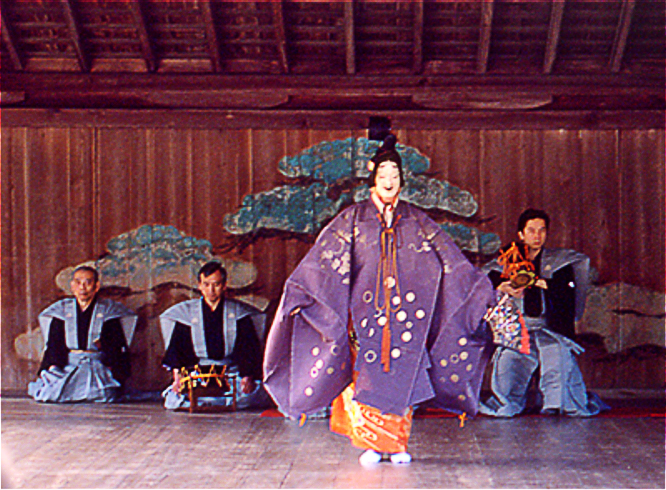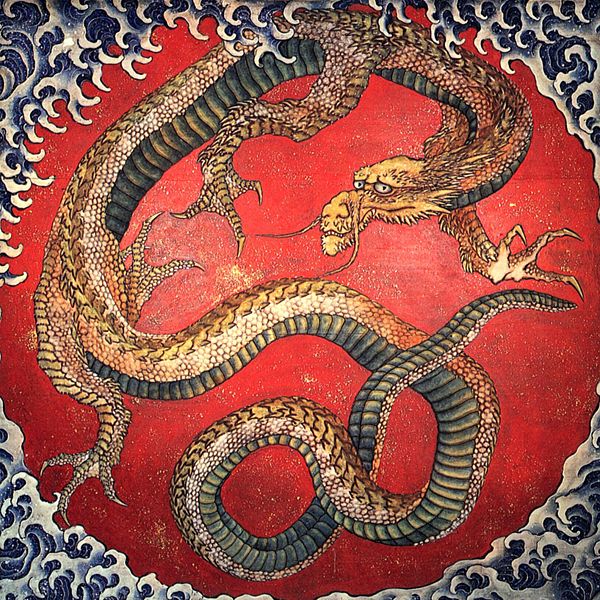READ: Japanese Theatre
1 Japanse Theatre: Noh
There are three kinds of distinct styles present in Japanese Theatre, Noh, Kabuki and Bunraku. The oldest form is Noh.


A Noh play unfolds around the recitation and dancing of a principle and secondary figure, while a seated Chorus chants a story, accented by solemn drum and flute music.
The dramatic action is mimed and highly stylized, with gestures designed to demonstrate intense emotions. These intense emotions are also shown through terse lyrical pose and dance. Standardized masks and brilliant costumes stand out starkly against an empty stage with its symbolic pine tree backdrop.
Noh stories depict legendary or historical events of a tragic cast, infused with Buddhist ideas. Noh is traditionally performed in sacred areas, such as specific temples.
The foreboding atmosphere is relived by comic interludes (kyogen), played during the intermission. Kyogen is the classical comic theater which balances the more serious Noh. While Noh is musical in nature, Kyogen emphasizes dialog. The two are traditionally performed alternately on the same program and they share a common heritage. Kyogen actors traditionally appear in interlude roles in Noh plays. Noh instrumentalists also sometimes appear in Kyogen plays. The training methods of the two forms are also similar.

The dramatic action is mimed and highly stylized, with gestures designed to demonstrate intense emotions. These intense emotions are also shown through terse lyrical pose and dance. Standardized masks and brilliant costumes stand out starkly against an empty stage with its symbolic pine tree backdrop.
Noh stories depict legendary or historical events of a tragic cast, infused with Buddhist ideas. Noh is traditionally performed in sacred areas, such as specific temples.
The foreboding atmosphere is relived by comic interludes (kyogen), played during the intermission. Kyogen is the classical comic theater which balances the more serious Noh. While Noh is musical in nature, Kyogen emphasizes dialog. The two are traditionally performed alternately on the same program and they share a common heritage. Kyogen actors traditionally appear in interlude roles in Noh plays. Noh instrumentalists also sometimes appear in Kyogen plays. The training methods of the two forms are also similar.

Acoustics of Noh Theatres. On the ceilings of such halls as the Shokokuji Temple, Tenryuji Temple and Myoshinji Temple in Kyoto are drawings of dragons.


In Shokokuji Temple, when you clap your hands, a long reverberating echo, traditionally called the "roaring dragon," is heard. This sound is in fact caused by the ceiling. A sound produced between two parallel planes, the floor and the ceiling, repeatedly bounces between them, causing acoustic reflections and subtle overlapping of echoes. The result is unique sound waves, or the "roar of the dragon." The dragons on the ceiling have known the secret of the sound for a long time!
Another secret, is that earthenware urns, like those used in the past in old style kitchens, are often placed underneath the stage of many Noh theatres for further acoustic effect. The urns vibrate and remit the sounds of the actors on the stage.
At some temples, when you walk on the floor, you hear the floor sing with your every step. This type of floor is called a Nightingale floor, and the singing sound is produced by the natural warping of the floorboards from long years of abuse by wind and rain, or the expanding of the holes in the wood due to the heavy load of people walking above.
Source:
Brockett, O.G. (1999) History of the Theatre, (8th ed). MA: Allyn & Bacon.
Another secret, is that earthenware urns, like those used in the past in old style kitchens, are often placed underneath the stage of many Noh theatres for further acoustic effect. The urns vibrate and remit the sounds of the actors on the stage.
At some temples, when you walk on the floor, you hear the floor sing with your every step. This type of floor is called a Nightingale floor, and the singing sound is produced by the natural warping of the floorboards from long years of abuse by wind and rain, or the expanding of the holes in the wood due to the heavy load of people walking above.
Source:
Brockett, O.G. (1999) History of the Theatre, (8th ed). MA: Allyn & Bacon.

